It’s bold predictions time again and I’ve got a mix of gut feelings and wrinkles that I’ve noticed and walked out to their logical conclusions. Remember, the spirit of these predictions matters more than the numbers themselves. I like to think I’m a bit smarter than the last time I did this, but also that I’m doing just as well in fun differential.
1. Calvin Faucher leads the Rays in saves
I don’t know if it exactly counts as bold to say some guy we barely know will lead the Rays in saves, but I think it counts if I’m calling my shot with a guy who might not end up making this team on Opening Day and had a 5.48 ERA in 21.1 major league IP last year. I believe very much in following stuff when it comes to relievers and Faucher’s name probably snuck way under the radar in this tweet last July.
Minimum 200 pitches, Stuff+ (movement, velo, spin, release info only) leaders:
1) Paul Sewald (148)
2) Felix Bautista
3) Calvin Faucher
4) Emmanuel Clase
5) Clay Holmes
6) Spencer Strider (lolol)
7) Matt Brash
8) Ryne Stanek
9) Bryan Abreu
10) Liam Hendriks (136)— Eno Sarris (@enosarris) July 3, 2022
Now, Faucher has struggled with command for his entire professional career, so it didn’t quite work out last year, but he was still a name that I wanted to follow. Next thing I know, he comes out this Spring and is throwing pitches like this:
Did anyone else clock Calvin Faucher's ridiculous slider from the other day? 85.8 mph with 17 inches of horizontal movement 👀👀
His stuff already graded out really well and now he adds 200 rpm and 10 inches of movement? Could be this year's Jason Adam. pic.twitter.com/wZKuvupFIt
— Eric Dadmun (@EricDadmun) March 16, 2023
Sliders that fast almost never have that much movement. It profiles like a Lance McCullers Jr. slider, but with four extra inches of movement. It’s like Penn Murfee’s slider, but six mph faster. Those were among the most effective sliders in the league last year and what Faucher broke out was a step above both of them. He’s faced eighteen batters this Spring and struck out eight of them (44.4% K-rate) while giving up just one hit. More importantly, though, he’s only walked one of them. The only thing we can expect with the Rays bullpen is the unexpected. I’m planting my flag calling Calvin Faucher this year’s Jason Adam.
2. Justin Steele and Hayden Wesneski outperform Alek Manoah and Chris Bassitt
Hayden Wesneski has become a very popular breakout candidate over the past couple of weeks due to his excellent Spring Training performance and, most recently, being confirmed as the Cubs’ fifth starter. PLV loves his slider and cutter and the results on his 158 sliders thrown last year, while few in number, support the idea of the slider as a pitch truly worthy of serving as the backbone of a solid pitch mix. He controls his pitches pretty well too, so while I believe the 25% K-rate he showed last year is likely a ceiling for him, I think he has a solid chance to be around a 22% K-rate—which totally works if he’s able to keep his walk rate around 6-8%, which everything we’ve seen from him indicates he can.
Moving to the other Cub I’m interested in, Justin Steele is a guy I feel doesn’t get properly evaluated by metrics like Stuff+ and PLV. His four-seamer was nearly historically difficult to barrel up last year. He didn’t allow a barrel on his first 786 four-seamers of the season and finished with a barrel rate of 2.1% on the 1,155 he threw, which ranks in the 99th percentile. For a pitch that both PLV and Stuff+ agree is pretty middling, this would be an extreme statistical anomaly. He talks in this article about how he can manipulate the movement of his fastball based on where he throws it. He is also among the league leaders in deviation between observed movement and spin-based movement on his fastball, which hints at seam-shifted wake playing a role.
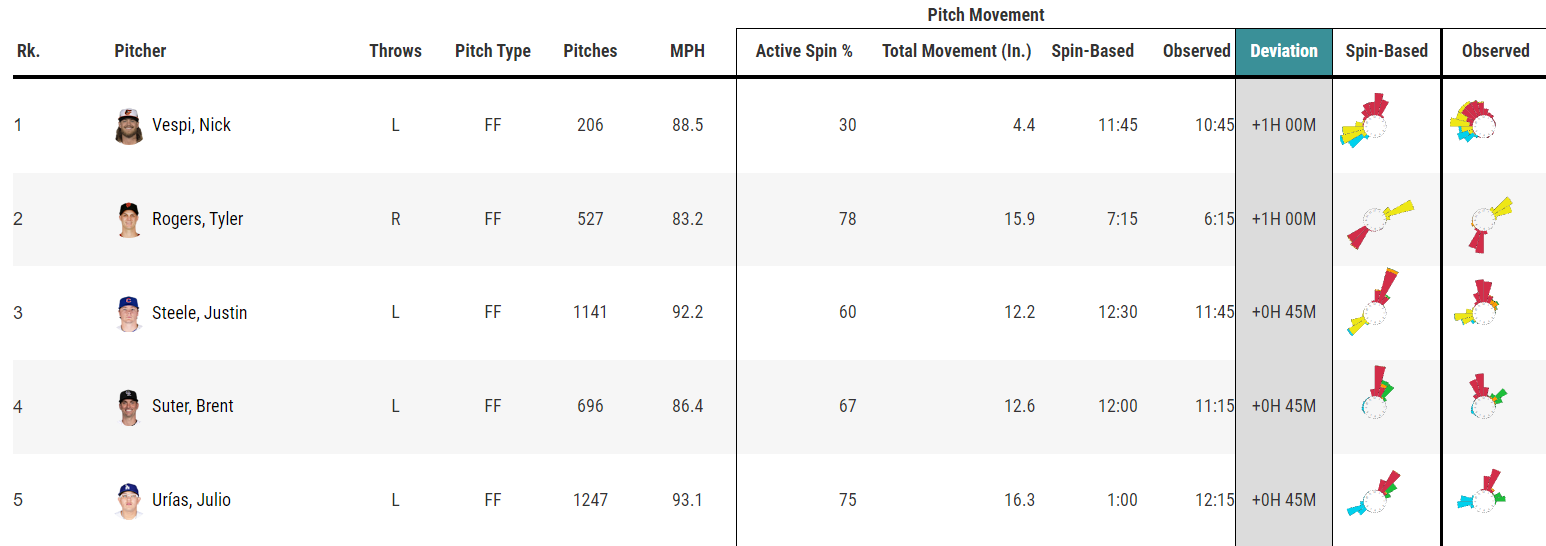
I believe that Steele’s many different ways of throwing his fastball are all being lumped together by Stuff+ and PLV, giving the impression of an overall less impressive fastball. In reality, I believe the changes in movement he has been able to induce plus the extra benefit of seam-shifted wake makes this pitch greater than the sum of its parts. I wouldn’t project higher than a 23% K-rate for him, but I think avoiding barrels is a skill that he will be able to carry forward into this year bringing him into an ERA in the mid 3’s rather than the high 3’s most projection systems are pegging him for.
On the flip side, Alek Manoah and Chris Bassitt have each had quite concerning velocity drops during Spring Training. There’s definitely hope that Manoah can still be a very serviceable starter since his slider has been getting whiffs this Spring, which could hint at an increased K-rate this season. But most projection systems have him around 190 IPs and 180 Ks on a 3.6 ERA. While I think Justin Steele likely comes out around 160 IPs, I think he can match the K-rate and ratios at a much lower price. Both are valuable fantasy starters, I believe.
Bassitt, on the other hand, is a guy I’m a bit concerned about. It’s true that throwing lots of pitches is correlated with going deeper in games and not many people in the league can compete with Bassitt’s eight pitch types. He did say that he was following a specific routine where he pitched at lower intensity in his first three outings which he said explained the velocity drop, but, according to this plan, he should be establishing a velocity floor for his regular season starts. His fourth appearance was March 17th. He was still two mph down on all of his pitches and struck out just one batter in five innings of work. He already struggled to get many swings and misses and a further reduction in velocity could drop his K-rate into the high teens. Combine that with a change in home park from one of the more pitcher-friendly parks to a balanced to slightly hitter-friendly Rogers Centre and you could have a 4.00 ERA guy with few strikeouts—and that doesn’t strike me as very interesting in anything more shallow than 15-team leagues.
3. Matthew Boyd and Eduardo Rodriguez combine for 28 wins and a 3.50 ERA over 320 IPs
Matthew Boyd is now going through his second stint as a popular late-round breakout pick. The fantasy community believed there was something more to him back in 2018 and even more were convinced when he put up 238 strikeouts in 2019. His main flaw was that he was a fairly extreme fly-ball pitcher. His 66 home runs allowed across the 2018 and 2019 seasons were second in the league to Dylan Bundy. The home run environment has completely changed league-wide between now and 2019 with 23% fewer home runs being hit in 2022 than 2019. Boyd would stand to benefit from this weakened home run environment as much as anyone.
Moreover, he’s now spent time with two different organizations—the Mariners and the Giants—and the latter have a pretty good track record of developing free-agent pitchers. Even a short time with them could provide a reason to believe that they could have put him on the road toward unlocking something. His 21:3 K:BB ratio in Spring Training has provided a good initial indication that Boyd might be ready to deliver on some of the promise of his 2019 season. The three homers provides an indication, for those who choose to look at it, that he might still be something between the 2018 and 2019 versions of himself, still struggling to keep away from the long ball, but I think there’s hope for him in this post-rabbit ball era.
Eduardo Rodriguez had a rough 2022 with a ribcage sprain that sent him to the IL in May and sprawled into a three-month absence for “family reasons” where the team struggled to be able to contact him at times. When he returned, though, he was able to be the pitcher the Tigers were hoping he’d be and delivered six quality starts in his final nine appearances of the year. If his Spring Training performance is any indication, he seems fully back to his 2019 form now. He may not provide the strikeout upside that Boyd does, but I think he has a higher chance of hitting 180 IPs and going deeper into games gives you more chances to come away with a win.
The reason I’m tying this bold prediction to wins is because I wanted the Tigers offense to play a role in the prediction as well. Riley Greene will get his own feature a little later in this article, but I think guys like Akil Baddoo, Spencer Torkelson, and, yes, even Javier Báez are due for some positive regression. Kerry Carpenter provides another interesting breakout option alongside Greene and they could all combine to create a slightly less anemic offense and a team that could win closer to 80 games than the 70 they’re currently being projected for. I don’t have them as a playoff team, but I think they have a more interesting young core than they are being given credit for.
4. Teoscar Hernández posts a 32% K-rate and hits under .230 for the year
Teoscar Hernández gets a downgrade both from changing parks and supporting cast. T-Mobile park in Seattle is one of the most unfriendly to offenses in the league. Being surrounded by Ty France and Eugenio Suárez is hardly the same thing as Vladimir Guerrero Jr. and Bo Bichette. These environmental factors also have the potential to bring up some problems that plagued him earlier in the year: strikeouts and, specifically, performance on the slider.
Teoscar Hernandez xwOBA against sliders:
2018: .274 (60th percentile) 🙂
2019: .239 (30th percentile) 🥱
2020: .208 (15th percentile) 🤢
2021: .355 (92nd percentile) 🚨
2022: .209 (15th percentile) 🤢More sliders are coming with less lineup protection in SEA. Can he handle it?
— Eric Dadmun (@EricDadmun) February 22, 2023
2021 was the outlier in terms of slider performance, so expecting him to return to that in this new, less friendly environment would be a tough ask. Teoscar is likely looking at seeing even more than the 24.7% sliders that he saw last year in Toronto given the new lineup protection he has. I think there’s a solid chance he regresses to the numbers he put up in 2018 and 2019 before the breakouts of the Blue Jays’ young batting core and before the arrival of George Springer. In those years, he sported a 32% strikeout rate and an average in the mid .230s.
5. Bobby Witt Jr.’s K-rate climbs to 25% and posts a wRC+ below 95
Bobby Witt Jr. gave a huge fantasy performance last year, but I think the hype on him has gone too far. He has some excellent contact skills on certain parts of the plate but still has some pretty big holes in his swing that I think pitchers will be able to exploit this year.
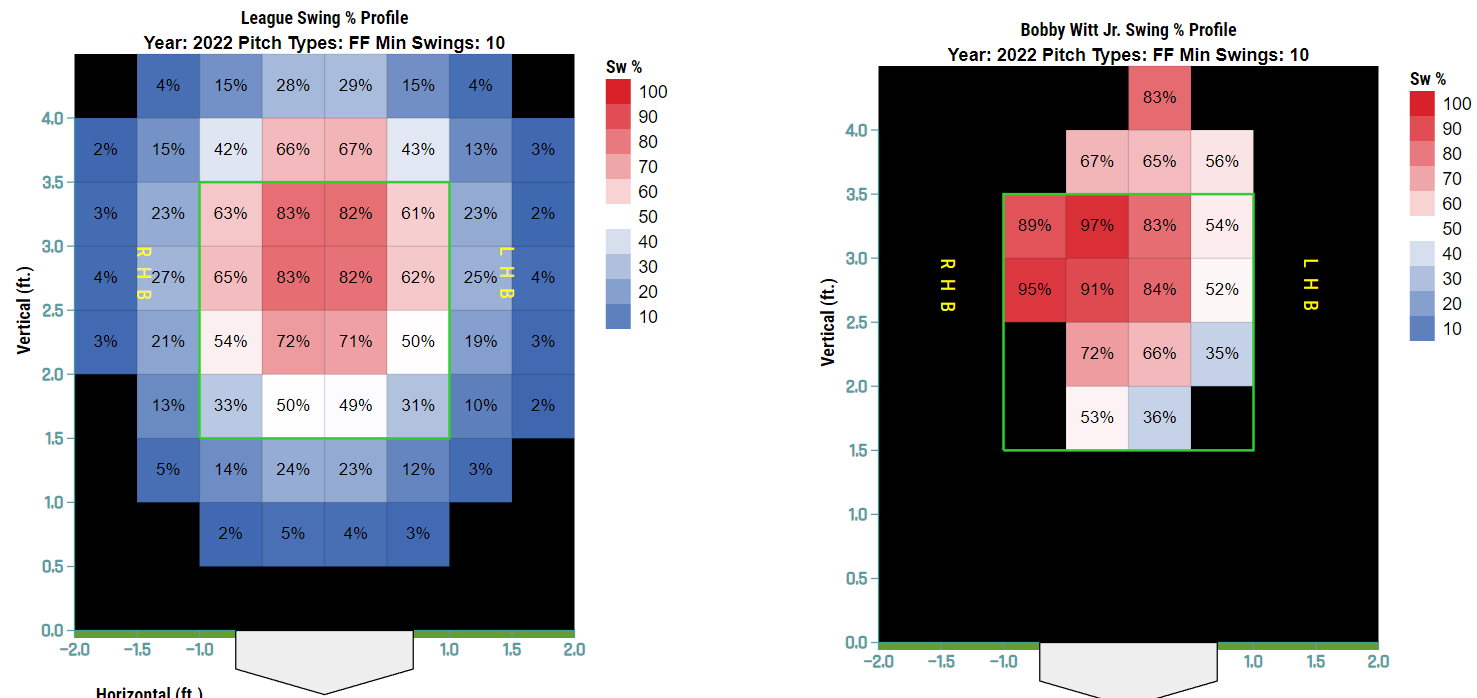
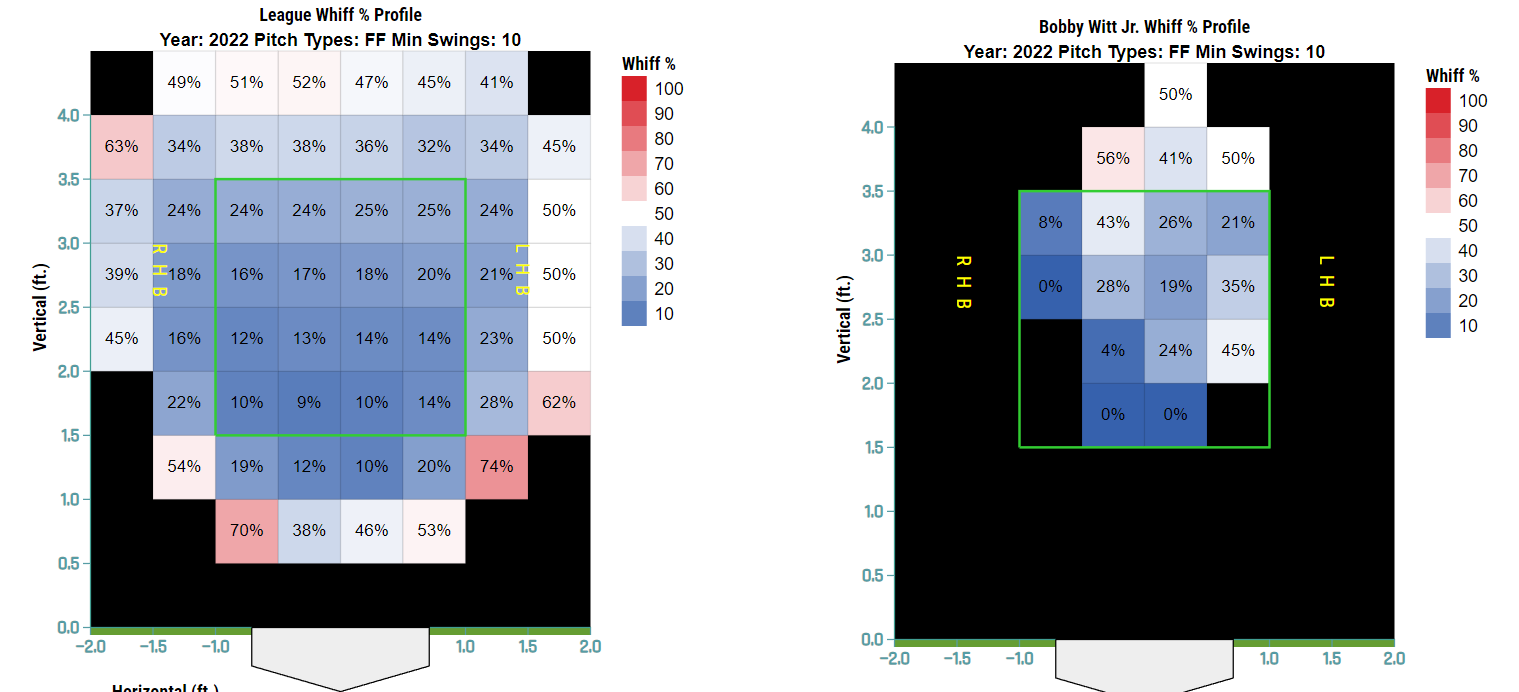
The first of these charts shows his swing percentage on fastballs in certain areas of the zone. Note the high swing rates up and on the inside part of the plate. The next chart shows his whiff percentage on those same swings. Don’t let the coloration of the chart fool you, those whiff rates of 56, 41, and 50% in the six inches above the zone are huge and he struggles to lay off those fastballs since they look like the up-and-in pitches he loves to turn on. As the team relies on his production more and more and the pressure rises on him to produce, I think it’s much more likely that his plate discipline takes a step back this year rather than continue to improve as all the projection systems and many experts seem to expect. He’ll hit some homers and steal some bases because he’s so quick on pitches on the inside part of the plate, but I think the package isn’t quite as complete as the ADP would have you believe.
6. Drew Rasmussen finishes top-5 in AL Cy Young race
Drew Rasmussen had all the makings of an ace in the second half last year with a 2.45 ERA, 0.93 WHIP, and 22% strikeout rate in 73.1 IPs. He also was more consistently stretched out later in the year as he went at least six innings in five out of his last six starts. He has a lot of qualities of a very reliable starter including a fastball that is difficult to square up and a cutter that gets him lots of ground balls. He’s also in an organization that does very well at developing their pitchers and I think there’s a good reason to expect some progression in the sweeping slider that he introduced last year. If it develops into a pitch that gets him more swings and misses and climbs his K-rate into the mid-20s, we could be looking at a guy who could join teammate Shane McClanahan in the Cy Young conversation. This is the Rays after all, so volume management likely keeps him out of the top three, but there’s a lot to like from Rasmussen
7. Trayce Thompson leads the Dodgers in home runs
I didn’t expect to be the high man on Trayce Thompson, but out of the four NFBC drafts I’ve done this year, he was the only one I got in all four. It’s not like I drafted him as a starter or anything, but he’s basically waiver-wire fodder even in 15-team leagues right now, and I think he’s an excellent low-risk, high-reward play at the end of drafts. First of all, his second half last year was crazy. He put up a .947 OPS and 164 wRC+ in 180 PAs. He showed the ability to hit at a very high level in the majors. Second, his power seems to have the potential to be near the top of the league. When predicting future next year’s ISO, previous year’s 80th percentile exit velocity turns out to be the most predictive and just take a look where Trayce Thompson ranks last year.
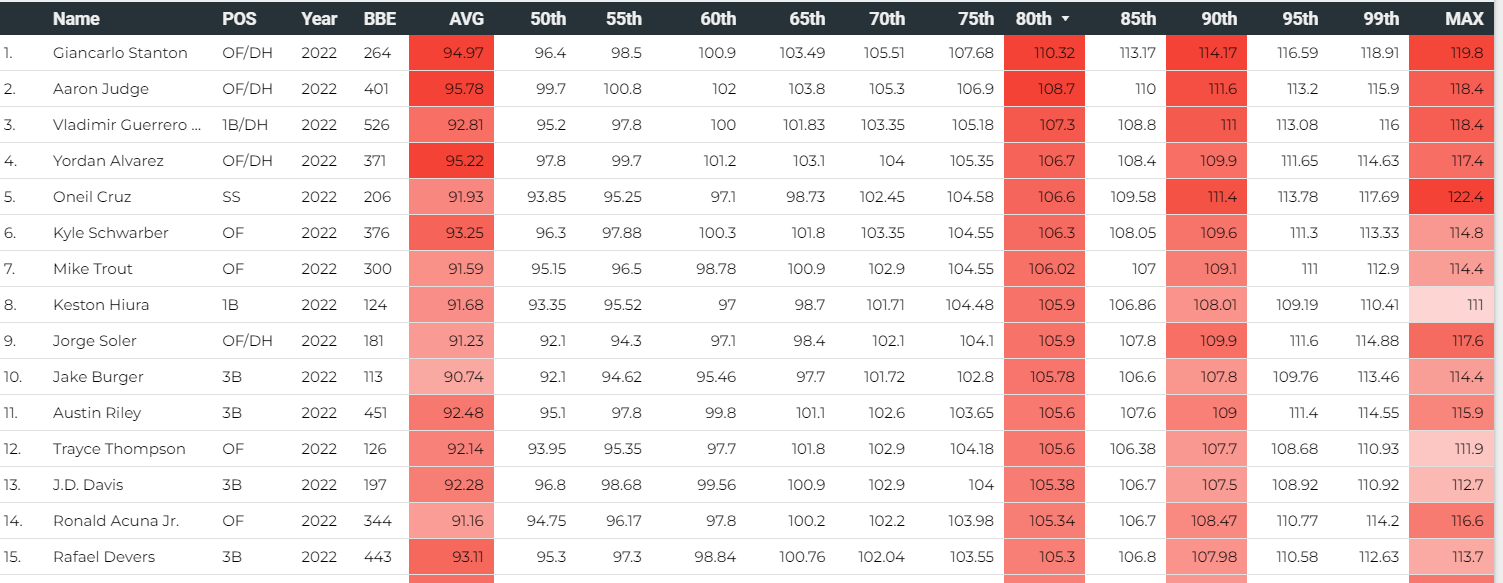
This is a veritable who’s who of the most prolific power hitters in the league. Thompson has some serious pop. Now, the elephant in the room. Keston Hiura is also on this list and we can’t overlook a 37% K-rate from Thompson last year. I will first note that it still came with a .256 average last year, a number that was supported by Statcast data. Second, his swinging strike rate fell to a much more manageable 13.4% in the second half. Yes, he’s probably going to have his share of slumps, but I don’t think this is Keston Hiura west.
The second big knock against Thompson is playing time. The Dodgers brought in veterans David Peralta and Jason Heyward and also informed James Outman that he made the Opening Day roster. They clearly wanted some extra depth to hedge against a very possible collapse. However, Heyward has had trouble staying on the field the past couple of seasons and Peralta is 35 and likely to need a fair share of rest days. In terms of per-PA rate, I think Thompson has more power than Mookie Betts and more than Max Muncy. Given that I’m unexpectedly the high man on Thompson, I figure I need to walk that out to its logical conclusion and that is that he manages to keep a respectable contact rate, gets 550 PAs, and leads this team in homers.
8. Riley Greene is a top-30 fantasy OF and goes 20-15 with a .270 average
From the beginning of writing this article to the end, I’ve seen a couple of different, prominent writers I respect put Riley Greene in their bold predictions or breakout lists. It could have convinced me to replace him with someone else, but I instead decided to keep it and jump on the bandwagon. Greene’s plate discipline in terms of K:BB didn’t seem to improve as the year went on, but PLV’s view of his strike zone judgment shows some real progression in the second half.
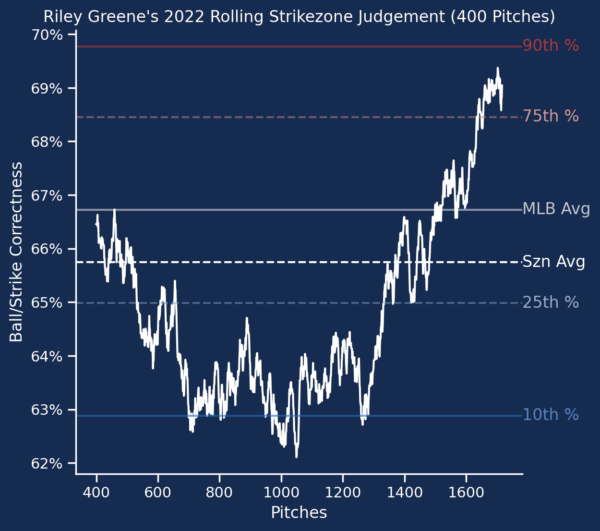
I think we could see some improvement in his strikeouts and walks as he goes into his second season. Last year was also close to a worst-case scenario for guys like Akil Baddoo, Spencer Torkelson, and Javier Báez. As there’s some regression to the mean, I think Greene benefits from an improved lineup environment as well as from a slightly improved park environment due to the changes in the dimensions of Comerica. He’s flashing quite a bit of power in the Spring with four homers in 55 PAs, but Spring homers are notoriously fickle and even I’m not willing to go to 25 homers here. An improved average from improving plate discipline, more R+RBI from an improving lineup, and a decent power-speed combo is the breakout story for Greene.
9. Triston Casas and Masataka Yoshida combine for 340 hits, a .380 OBP, and a 125 wRC+
It was pretty surprising when Steamer projections first came out in January to see Masataka Yoshida with a projected 140 wRC+ and a top-15 hitter in the league in his rookie year. Currently, he is projected at 16th in wRC+, just ahead of some big names in Corey Seager, Ronald Acuña Jr., and Julio Rodríguez. He’s continued to impress both in camp and at the WBC where he set a record for RBIs. The team was so impressed with him that they said he’d hit cleanup instead of first or second as expected. This makes me wonder if there isn’t some power the Red Sox believes they can unlock here. What isn’t up for debate is an elite eye and solid hit tool in the middle of what I think should be at least a league-average offense.
We have a bit more Spring Training and Major League data on the other part of this prediction and Triston Casas has been raking. With a 1.012 OPS in 58 PAs, Casas has been one of the most dangerous bats in Florida in March. His 26% K-rate, while not ideal, is certainly manageable given the amount of pop in his bat. His 20% walk rate in his cup of coffee last year is something you don’t often see. He wasn’t pressing and forcing himself into lots of swings and misses even though he was getting his first action at the big league level. This is a good version of a ‘three true outcomes’ type of guy with a strikeout in the mid-20s and an average, I think, closer to .260 than the low .200s. I’m excited to watch both of these guys and I think they could propel the Red Sox offense back to a respectable place.
10. Blake Sabol is a top-15 catcher-eligible player
A rough Arizone Fall League performance is clouding an otherwise really interesting set of minor league stats from Blake Sabol and his impressive performance has continued into this Spring. Sabol had 101 plate appearances in Triple-A last year and put up a 157 wRC+ with a 17% walk rate and 22% K-rate. In his 58 Spring plate appearances, he’s hitting .349 with three home runs and, most impressively to me, 11 walks. His 19% walk rate this Spring shows a plate discipline that I think can carry over to the big leagues. The injury to Mitch Haniger has opened up a spot on the Opening Day roster for Sabol and he likely starts against righties for at least the first couple weeks of the season. He’d normally be a watchlist type of guy, but given that he has catcher eligibility, he becomes, to me, a must-add in two catcher leagues. By the time you get to C24, you’re getting so little from the position that you should be jumping on any opportunity to get some production out of the role and I think Sabol, at least for a while, could provide that.

I love these lists – thank you!
I thought Sabol’s roster residency was safe due to being a rule 5 selection but I see he was traded from CIN to SF…so that means that the Giants could send him down? Of course…not if he hits. He has looked good this spring.
Number 7 is looking pretty good already. I seriously considered taking Thompson in my 15-teamer, who apparently had the fastest bat speed among Dodger hitters. But in the end, I couldn’t bring myself to hit that “draft” button, as I worried that a player in their 30s wouldn’t be able to cut down on the Ks. One monster game does not a season make, but I knew the Dodgers had to be sticking with him for a reason, and I should have gone with my gut. (I’ve returned to playing fantasy for the first time since 2014, so lacking confidence, I ignored my gut on a few players. I already regret it.)